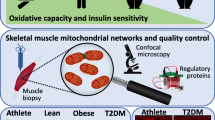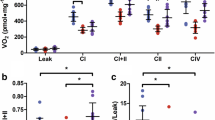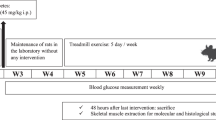Abstract
Background
Mitochondrial dynamics disorders contribute to the pathogenesis of many diseases involving type 2 diabetes. It appears that exercise training is a strategy for reversing the unbalance between fusion and fission, but, to our understanding, effects of aerobic exercise on this particular issue have not been studied in cardiac myocytes.
Aims
To demonstrate if 12 weeks of aerobic exercise has a significant impact on Dynamin Related Protein 1 (DRP1), Mitofusin2 (MFN2) and Optic Atrophy 1 (OPA1) expressions in cardiac muscle of type 2 diabetic rats.
Methods
10 Wistar rats with an average age of 10 weeks were divided randomly into two groups of five: diabetic control and diabetic exercise. The latter was submitted to a 12-week (5 days a week, 30 min/day) aerobic exercise. 48 h after the last session of exercise, cardiac samples were obtained for genetic experiments. T-test was used for data analysis at p ≤ 0.05.
Results
OPA1 expression was increased significantly (p = 0.03) while MFN2 and DRP1 expressions were elevated insignificantly (p = 0.165, p = 0.19).
Conclusion
This study shows that aerobic training is likely to regulate mitochondrial fission and fusion in cardiac muscle of type 2 diabetic rats. Although more research is necessary.

Similar content being viewed by others
Notes
Prolyl-hydroxylases.
Body weight.
Streptozotocin.
Enzyme-linked immunosorbent assay.
AMP-activated protein kinase.
Oxidative phosphorylation.
References
Archer SL (2013) Mitochondrial dynamics–mitochondrial fission and fusion in human diseases. N Engl J Med 369:2236–2251. https://doi.org/10.1056/NEJMra1215233
Sivitz WI, Yorek MA (2010) Mitochondrial dysfunction in diabetes: from molecular mechanisms to functional significance and therapeutic opportunities. Antioxid Redox Signal 12:537–577. https://doi.org/10.1089/ars.2009.2531
Ishihara N, Otera H, Oka T, Mihara K (2012) Regulation and physiologic functions of GTPases in mitochondrial fusion and fission in mammals. Antioxid Redox Signal 19:121001062245003. https://doi.org/10.1089/ars.2012.4830
Yoon Y, Krueger EW, Oswald BJ, McNiven MA (2003) The mitochondrial protein hFis1 regulates mitochondrial fission in mammalian cells through an interaction with the dynamin-like protein DLP1. Mol Cell Biol 23:5409–5420. https://doi.org/10.1128/MCB.23.15.5409-5420.2003
Cipolat S, Martins de Brito O, Dal Zilio B, Scorrano L (2004) OPA1 requires mitofusin 1 to promote mitochondrial fusion. Proc Natl Acad Sci USA 101:15927–15932. https://doi.org/10.1073/pnas.0407043101
Chen H, Detmer SA, Ewald AJ, Griffin EE, Fraser SE, Chan DC (2003) Mitofusins Mfn1 and Mfn2 coordinately regulate mitochondrial fusion and are essential for embryonic development. J Cell Biol 160:189–200. https://doi.org/10.1083/jcb.200211046
Santel A, Fuller MT (2001) Control of mitochondrial morphology by a human mitofusin. J Cell Sci 114:867–874
Youle RJ, van der Bliek AM (2012) Mitochondrial fission, fusion, and stress. Science 337:1062–1065. https://doi.org/10.1126/science.1219855
Bach D, Pich S, Soriano FX, Vega N, Baumgartner B, Oriola J, Daugaard JR, Lloberas J, Camps M, Zierath JR, Rabasa-Lhoret R, Wallberg-Henriksson H, Laville M, Palacín M, Vidal H, Rivera F, Brand M, Zorzano A (2003) Mitofusin-2 determines mitochondrial network architecture and mitochondrial metabolism: a novel regulatory mechanism altered in obesity. J Biol Chem 278:17190–17197. https://doi.org/10.1074/jbc.M212754200
Bakeeva LE, Chentsov YS, Skulachev VP (1978) Mitochondrial framework (reticulum mitochondriale) in rat diaphragm muscle. BBA Bioenerg 501:349–369. https://doi.org/10.1016/0005-2728(78)90104-4
Kirkwood SP, Munn EA, Brooks GA (1986) Mitochondrial reticulum in limb skeletal muscle. Am J Physiol 251:C395–402
Wai T, Langer T (2016) Mitochondrial dynamics and metabolic regulation. Trends Endocrinol Metab 27:105–117. https://doi.org/10.1016/j.tem.2015.12.001
Lee Y, Jeong S, Karbowski M, Smith C, Youle R (2004) Roles of the mammalian mitochondrial fission and fusion mediators Fis1, Drp1, and Opa1 in apoptosis. Mol Biol Cell 15:5001–5015
Ikeda Y, Sciarretta S, Nagarajan N, Rubattu S, Volpe M, Frati G, Sadoshima J (2014) New insights into the role of mitochondrial dynamics and autophagy during oxidative stress and aging in the heart. Oxid Med Cell Longev. https://doi.org/10.1155/2014/210934
Kelley DE, He J, Menshikova EV, Ritov VB (2002) Dysfunction of mitochondria in human skeletal muscle in type 2 diabetes. Diabetes 51:2944–2950. https://doi.org/10.2337/diabetes.51.10.2944
Mootha VK, Lindgren CM, Eriksson K-F, Subramanian A, Sihag S, Lehar J, Puigserver P, Carlsson E, Ridderstråle M, Laurila E, Houstis N, Daly MJ, Patterson N, Mesirov JP, Golub TR, Tamayo P, Spiegelman B, Lander ES, Hirschhorn JN, Altshuler D, Groop LC (2003) PGC-1α-responsive genes involved in oxidative phosphorylation are coordinately downregulated in human diabetes. Nat Genet 34:267–273. https://doi.org/10.1038/ng1180
Patti ME, Butte AJ, Crunkhorn S, Cusi K, Berria R, Kashyap S, Miyazaki Y, Kohane I, Costello M, Saccone R, Landaker EJ, Goldfine AB, Mun E, DeFronzo R, Finlayson J, Kahn CR, Mandarino LJ (2003) Coordinated reduction of genes of oxidative metabolism in humans with insulin resistance and diabetes: potential role of PGC1 and NRF1. Proc Natl Acad Sci USA 100:8466–8471. https://doi.org/10.1073/pnas.1032913100
Bach D, Naon D, Pich S, Soriano FX, Vega N, Rieusset J, Laville M, Guillet C, Boirie Y, Wallberg-Henriksson H, Manco M, Calvani M, Castagneto M, Palacín M, Mingrone G, Zierath JR, Vidal H, Zorzano A (2005) Expression of Mfn2, the charcot-marie-tooth neuropathy type 2A gene, in human skeletal muscle. Diabetes 54:2685–2693. https://doi.org/10.2337/diabetes.54.9.2685
Zorzano A, Hernández-Alvarez MI, Palacín M, Mingrone G (2010) Alterations in the mitochondrial regulatory pathways constituted by the nuclear co-factors PGC-1α or PGC-1β and mitofusin 2 in skeletal muscle in type 2 diabetes. Biochim Biophys Acta Bioenerg 1797:1028–1033. https://doi.org/10.1016/j.bbabio.2010.02.017
Sebastián D, Hernández-Alvarez MI, Segalés J, Sorianello E, Muñoz JP, Sala D, Waget A, Liesa M, Paz JC, Gopalacharyulu P, Orešič M, Pich S, Burcelin R, Palacín M, Zorzano A (2012) Mitofusin 2 (Mfn2) links mitochondrial and endoplasmic reticulum function with insulin signaling and is essential for normal glucose homeostasis. Proc Natl Acad Sci USA 109:5523–5528. https://doi.org/10.1073/pnas.1108220109
Nochez Y, Arsene S, Gueguen N, Chevrollier A, Ferré M, Guillet V, Desquiret V, Toutain A, Bonneau D, Procaccio V, Amati-Bonneau P, Pisella P-J, Reynier P (2009) Acute and late-onset optic atrophy due to a novel OPA1 mutation leading to a mitochondrial coupling defect. Mol Vis 15:598–608
Evans JL, Goldfine ID, Maddux BA, Grodsky GM (2003) Are oxidative stress-activated signaling pathways mediators of insulin resistance and β-cell dysfunction? Diabetes 52:1–8. https://doi.org/10.2337/diabetes.52.1.1
Favier FB, Britto FA, Poncon B, Begue G, Chabi B, Reboul C, Meyer G, Py G (2015) Endurance training prevents negative effects of the hypoxia mimetic dimethyloxalylglycine on cardiac and skeletal muscle function. J Appl Physiol. https://doi.org/10.1152/japplphysiol.00171.2015
Perry CGR, Lally J, Holloway GP, Heigenhauser GJF, Bonen A, Spriet LL (2010) Repeated transient mRNA bursts precede increases in transcriptional and mitochondrial proteins during training in human skeletal muscle. J Physiol 588:4795–4810. https://doi.org/10.1113/jphysiol.2010.199448
Bo H, Zhang Y, Ji LL (2010) Redefining the role of mitochondria in exercise: a dynamic remodeling. Ann N Y Acad Sci 1201:121–128. https://doi.org/10.1111/j.1749-6632.2010.05618.x
Ding H, Jiang N, Liu H, Liu X, Liu D, Zhao F, Wen L, Liu S, Ji LL, Zhang Y (2010) Response of mitochondrial fusion and fission protein gene expression to exercise in rat skeletal muscle. Biochim Biophys Acta Gen Subj 1800:250–256. https://doi.org/10.1016/j.bbagen.2009.08.007
Jiang HK, Wang YH, Sun L, He X, Zhao M, Feng ZH, Yu XJ, Zang WJ (2014) Aerobic interval training attenuates mitochondrial dysfunction in rats post-myocardial infarction: roles of mitochondrial network dynamics. Int J Mol Sci 15:5304–5322. https://doi.org/10.3390/ijms15045304
Szkudelski T (2012) Streptozotocin-nicotinamide-induced diabetes in the rat. Characteristics of the experimental model. Exp Biol Med (Maywood) 237(5):481–490. https://doi.org/10.1258/ebm.2012.011372
Pierre W, Gildas AJH, Ulrich MC, Modeste W-N, Benoît NT, Albert K (2012) Hypoglycemic and hypolipidemic effects of Bersama engleriana leaves in nicotinamide/streptozotocin-induced type 2 diabetic rats. BMC Complement Altern Med 12:264. https://doi.org/10.1186/1472-6882-12-264
Mogharnasi M, Gaeini A, Sheikholeslami Vatani D, Rahnama N, Arjmandi B, Bambaeichi E (2011) Effect of acute and prolonged periods of aerobic training and detraining on novel inflammatory marker: the predictive of cardiovascular disease in Wistar rats. Gazz Medica Ital Arch Per Le Sci Mediche 170:307–313
Lawler JM, Powers SK, Hammeren J, Martin AD (1993) Oxygen cost of treadmill running in 24-month-old Fischer-344 rats. Med Sci Sports Exerc 25:1259–1264. https://doi.org/10.1249/00005768-199311000-00009
Taji Tabas A, Mogharnasi M (2015) The effect of 10 week resistance exercise training on serum levels of nesfatin-1 and insulin resistance index in woman with type 2 diabetes. Iran J Diabetes Metab 14:179–188
Cheng K-CC, Asakawa A, Li Y-XX, Chung H-HH, Amitani H, Ueki T, Cheng J-TT, Inui A (2014) Silymarin induces insulin resistance through an increase of phosphatase and tensin homolog in wistar rats. PLoS ONE 9:e84550. https://doi.org/10.1371/journal.pone.0084550
Katz A, Nambi SS, Mather K, Baron AD, Follmann DA, Sullivan G, Quon MJ (2000) Quantitative insulin sensitivity check index: a simple, accurate method for assessing insulin sensitivity in humans. J Clin Endocrinol Metab 85:2402–2410. https://doi.org/10.1210/jc.85.7.2402
Gaeini AA, Bahramian A, Javidi M (2013) The effect of eight weeks of resistance training on stimulatory and inhibitory factors of cardiac microvascular injuries in Wistar diabetic rats. JME 3:21–32
Jorge L, Paulini J, Silva C, Rampaso R, Luiz R, Lima W, Scavasin G, Schor N (2013) Exercise training improves cardiac mitofusin 2 expression in diabetes. Hypertension 62:613
Fealy CE, Mulya A, Lai N, Kirwan JP (2014) Exercise training decreases activation of the mitochondrial fission protein dynamin-related protein-1 in insulin resistant human skeletal muscle. J Appl Physiol. https://doi.org/10.1152/japplphysiol.01064.2013
Walder K, Kerr-Bayles L, Civitarese A, Jowett J, Curran J, Elliott K, Trevaskis J, Bishara N, Zimmet P, Mandarino L, Ravussin E, Blangero J, Kissebah A, Collier GR (2005) The mitochondrial rhomboid protease PSARL is a new candidate gene for type 2 diabetes. Diabetologia 48:459–468. https://doi.org/10.1007/s00125-005-1675-9
Hernandez-Alvarez MI, Thabit H, Burns N, Shah S, Brema I, Hatunic M, Finucane F, Liesa M, Chiellini C, Naon D, Zorzano A, Nolan JJ (2010) Subjects with early-onset type 2 diabetes show defective activation of the skeletal muscle PGC-1α/mitofusin-2 regulatory pathway in response to physical activity. Diabetes Care 33:645–651. https://doi.org/10.2337/dc09-1305
Holloszy JO, Coyle EF (1984) Adaptations of skeletal muscle to endurance exercise and their metabolic consequences. J Appl Physiol 56:831–838
Cartoni R, Leger B, Hock MB, Praz M, Crettenand A, Pich S, Ziltener JL, Luthi F, Deriaz O, Zorzano A, Gobelet C, Kralli A, Russell AP (2005) Mitofusins 1/2 and ERRα expression are increased in human skeletal muscle after physical exercise. J Physiol 567:349–358. https://doi.org/10.1113/jphysiol.2005.092031
Joseph A-M, Joanisse DR, Baillot RG, Hood DA (2012) mitochondrial dysregulation in the pathogenesis of diabetes: potential for mitochondrial biogenesis-mediated interventions. Exp Diabetes Res. https://doi.org/10.1155/2012/642038
Shen T, Zheng M, Cao C, Chen C, Tang J, Zhang W, Cheng H, Chen KH, Xiao RP (2007) Mitofusin-2 is a major determinant of oxidative stress-mediated heart muscle cell apoptosis. J Biol Chem 282:23354–23361. https://doi.org/10.1074/jbc.M702657200
Ikeda Y, Sciarretta S, Nagarajan N, Rubattu S, Volpe M, Frati G, Sadoshima J (2014) New insights into the role of mitochondrial dynamics and autophagy during oxidative stress and aging in the heart. Oxid Med Cell Longev. https://doi.org/10.1155/2014/210934
Ziolkowski W, Flis DJ, Halon M, Vadhana DMS, Olek RA, Carloni M, Antosiewicz J, Kaczor JJ, Gabbianelli R (2015) Prolonged swimming promotes cellular oxidative stress and p66Shc phosphorylation, but does not induce oxidative stress in mitochondria in the rat heart. Free Radic Res 49:7–16. https://doi.org/10.3109/10715762.2014.968147
Benedini S, Caimi A, Alberti G, Terruzzi I, Dellerma N, La Torre A, Luzi L (2010) Increase in homocysteine levels after a half-marathon running: a detrimental metabolic effect of sport? Sport Sci Health 6:35–42. https://doi.org/10.1007/s11332-010-0094-6
Wang K, Klionsky DJ (2011) Mitochondria removal by autophagy. Autophagy 7:297–300. https://doi.org/10.4161/auto.7.3.14502
Sciarretta S, Zhai P, Volpe M, Sadoshima J (2012) Pharmacological modulation of autophagy during cardiac stress. J Cardiovasc Pharmacol 60:235–241. https://doi.org/10.1097/FJC.0b013e3182575f61
Melov S, Hinerfeld D, Esposito L, Wallace DC (1997) Multi-organ characterization of mitochondrial genomic rearrangements in ad libitum and caloric restricted mice show striking somatic mitochondrial DNA rearrangements with age. Nucleic Acids Res 25:974–982. https://doi.org/10.1093/nar/25.5.974
Yan Z, Lira VA, Greene NP (2012) Exercise training-induced regulation of mitochondrial quality. Exerc Sport Sci Rev 40:159–164. https://doi.org/10.1097/JES.0b013e3182575599
Finkel T, Holbrook NJ, Alberti A, Bolognini L, Macciantelli D, Caratelli M, Aviram M, Bełtowski J, Wójcicka G, Marciniak A, Capeillère-Blandin C, Gausson V, Descamps-Latscha B, Witko-Sarsat V, Chen S, Nilsen J, Brinton RD, Droge W, Erel O, Finkel T, Holbrook NJ, Jacobs AH, Winkler A, Castro MG, Lowenstein P, Johnson GL, Lapadat R, Khersonsky O, Tawfik DS, Gu X, Huang Y, Levison BS, Gerstenecker G, DiDonato AJ, Hazen LB, Lee J, Gogonea V, DiDonato JA, Hazen SL, Wu Z, Riwanto M, Gao S, Levison BS, Gu X, Fu X, Wagner MA, Besler C, Gerstenecker G, Zhang R, Li X, DiDonato AJ, Gogonea V, Tang WHW, Smith JD, Plow EF, Fox PL, Shih DM, Lusis AJ, Fisher EA, DiDonato JA, Landmesser U, Hazen SL, Matsuoka Y, Picciano M, La Francois J, Duff K, Mtsuokaa Y, Picciano M, La Francois J, Duff K, Mills E, Dong X, Fudi W, Xu H, Praticò D, Rosenblat M, Gaidukov L, Khersonsky O, Vaya J, Oren R, Tawfik DS, Aviram M, Yin F, Yao J, Sancheti H, Feng T, Melcangi RC, Morgan TE, Finch CE, Pike CJ, Mack WJ, Cadenas E, Brinton RD, McGrath LT, McGleenon BM, Brennan S, McColl D, McILroy S, Passmore AP, Wildsmith KR, Holley M, Savage JC, Skerrett R, Landreth GE, Hayashi H, Gupta A, Iadecola C, Vitali C, Wellington CL, Calabresi L, Cervellati C, Bergamini CM, Mckhann GM, Knopman DS, Chertkow H, Hyman BT, Jack CR, Kawas CH, Klunk WE, Koroshetz WJ, Manly JJ, Mayeux R, Mohs RC, Morris JC, Rossor MN, Scheltens P, Carillo MC, Thies B, Weintraub S, Phelps CH, Gu X, Huang Y, Levison BS, Gerstenecker G, DiDonato AJ, Hazen LB, Lee J, Gogonea V, DiDonato JA, Hazen SL, Klosinski LP, Yao J, Yin F, Fonteh AN, Harrington MG, Christensen TA, Trushina E, Diaz R, Qm C, Simulations MM, Oxon MC, Furlong CE, Richter RJ, Seidel SL, Motulsky AG, Wojtunik-kulesza KA, Oniszczuk A, Oniszczuk T, Waksmundzka-hajnos M (2000) Oxidants, oxidative stress and the biology of ageing. Nature 408:239–247. https://doi.org/10.1038/35041687
Parone PA, Da Druz S, Tondera D, Mattenberger Y, James DI, Maechler P, Barja F, Martinou JC (2008) Preventing mitochondrial fission impairs mitochondrial function and leads to loss of mitochondrial DNA. PLoS ONE. https://doi.org/10.1371/journal.pone.0003257
Funding
This research did not receive any specific grant from funding agencies in the public, commercial, or not-for-profit sectors.
Author information
Authors and Affiliations
Corresponding author
Ethics declarations
Conflict of interest
The authors have no conflict of interest relevant to this article.
Ethical approval
All applicable international, national, and/or institutional guidelines for the care and use of animals were followed.
Informed consent
For this type of study, formal consent is not required.
Rights and permissions
About this article
Cite this article
Zafaranieh, S., Choobineh, S. & Soori, R. The effect of 12 weeks of aerobic exercise on mitochondrial dynamics in cardiac myocytes of type 2 diabetic rats. Sport Sci Health 14, 305–312 (2018). https://doi.org/10.1007/s11332-018-0430-9
Received:
Accepted:
Published:
Issue Date:
DOI: https://doi.org/10.1007/s11332-018-0430-9




